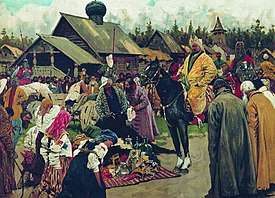Darughachi
Darughachi (Mongol form) or Basqaq (Turkic form) which originally designated officials in the Mongol Empire in charge of taxes and administration in a certain province, is the plural form of the Mongolian word darugha.[1] They were sometimes referred to as governors.[2] The term corresponds to the Persian داروغه dārugheh[3] and the Turkic basqaq (also spelled baskak) and to ta lu hua ch'ih (in Wade–Giles romanization, 達魯花赤 in Traditional Chinese characters, 达鲁花赤 in Simplified Chinese characters, dálǔhuāchì in Pinyin romanization) in Chinese.

History
This title was established under the rule of Genghis Khan from 1211.[1]
When the khagan Ögödei defeats Jin Dynasty (1115-1234) (Chin), he places alginči, tammačin and darugačin in Nanging and Jungdu.[4]
The Secret History of the Mongols tells us that after the invasion and conquest of the kiptchaks and Rus' countries between 1237 and 1240, Ögödei places daruγačin and tammačin for to govern the peoples whose cities are Ornas, Saḳsīn, Bolghar and Kiev.[4]
Under the Yuan Dynasty, it is replaced by the title of Zhangguan and there was one for each administrative subdivision , where he combined the functions of governor and chief of the armies. This title was also given to a person at the head of a central government office. This charge usually fell to a Mongol, probably to a Semu, thus guaranteeing the preservation of power within the Mongols. Some other populations, however, could have an administrative title with close functions.
Under the Golden Horde, there was also an official named Chinese: 八思哈
| Darughachi | |||||||
|---|---|---|---|---|---|---|---|
| Chinese name | |||||||
| Chinese | 達魯花赤 | ||||||
| |||||||
| Mongolian name | |||||||
| Mongolian script | ᠳᠠᠷᠤᠭᠠᠴᠢ | ||||||
| |||||||
The texts of Yanghe, in the Uighur dialect of Tourfan say that he should be paid a large sum of gold and silver when the Darugha Turfan was replaced.[5]
The Turkic term basqaq does not appear in Mongolian sources.[4] In Russian sources, the darughachi were almost always referred to as baskak (plural baskaki).[6] They appear in the thirteenth-century soon after the Mongol Conquest but were withdrawn by 1328 and the Grand Prince of Vladimir (usually the Prince of Moscow) became the khan's tax collector and imperial son in law (kürgen), entrusted with gathering the dan' or tribute from the Rus' principalities for the Golden Horde.[7]
In the 13th century, chiefs of Mongol darughas were stationed in Vladimir[8] and Baghdad.[9]
The Mongol Empire attempted to send darughachi to Goryeo of Korea in 1231, after the first (of six) invasions. According to some records, 72 darughachi were sent and Mongol military garrisons withdrawn. However, repeated rebellions and continued Goryeo resistance to Mongol dominion (the original darughachi that were stationed were all killed by Goryeo forces in the summer of 1232) made the stationing of darughachi difficult.[10] While there are questions regarding the actual number of darughachi stationed (the extant record denoting 72 darughachi was itself a derivation of an older record that has been lost; Goryeo was too small a territory to merit so many darughachi; the names of none of the 72 darughachi remain, which is unusual considering the importance of their position), most reliable sources (including the Goryeo-sa) indicate that at least some darughachi were stationed in Goryeo for the duration of its vassaldom to the Mongol Empire.[11] While further mention of the darughachi in Korea is scarce in extant sources, after peace was secured between Goryeo and the Mongol Empire in 1259 establishing Korea as a vassal to the Empire, the stationing of darughachi in Korea was likely a more stable proposition.
After 1921 the word darga (boss) (Khalkha pronunciation of darugha) replaced the aristocratic noyan as the term for high-level officials in Mongolia.[12]
See also
References
- Britnell, R. H. (1997). Pragmatic literacy, East and West, 1200–1330. The Boydell Press. p. 223. ISBN 978-0-85115-695-8. Retrieved June 13, 2011.
- Elizabeth Endicott-West, Mongolian Rule in China, Local Administration in the Yuan Dynasty (Cambridge: Harvard University Press, 1989); Idem, " Imperial Governance in Yuan Times," Harvard Journal of Asiatic Studies, 46.2 (1986): 523–549.
- Dehkhoda Persian dictionary: داروغه . [ غ َ / غ ِ ] (ترکی – مغولی ، اِ) رئیس شبگردان . سرپاسبانان . داروغه که در زبان مغولی به معنی «رئیس » است یک اصطلاح عمومی اداری است Archived 2011-07-18 at the Wayback Machine
- Donald Ostrowski The tamma and the Dual-Administrative Structure of the Mongol Empire Bulletin of the School of Oriental and African Studies, University of London, vol. 61, no 2, 1998, p. 262-277 doi: 10.1017/S0041977X0001380X
- Abdurishid Yakup, The Turfan Dialect of Uyghur, Otto Harrassowitz Verlag, 2005 p. 300
- See for example the reference to one under the year 1269 in A. N. Nasonov, ed., Novgorodskaia Pervaia Letopis Starshego i Mladshego Izvodov (Moscow and Leningrad: AN SSSR, 1950), 319.
- Charles J. Halperin, Russia and the Golden Horde: The Mongol Impact on Medieval Russian History(Bloomington: Indiana University Press, 1987); Donald Ostrowski, Muscovy and the Mongols: Cross-Cultural Influences on the Steppe Frontier, 1304–1589 (Cambridge: Cambridge University Press, 1998).
- Henry Hoyle Howorth-History of the Mongols from the 9th to the 19th Century. Part 2., p.128
- Judith G. Kolbas-The Mongols in Iran: Chingiz Khan to Uljaytu, 1220–1309, p.156
- "Henthorn, W. E., Korea: The Mongol Invasions, p. 71. Leiden, the Netherlands: E. J. Brill, 1963."
- "Henthorn, W. E., Korea: The Mongol Invasions, p. 72. Leiden, the Netherlands: E. J. Brill, 1963."
- C.P.Atwood Encyclopedia of Mongolia and the Mongol Empire, 2004 ISBN 0816046719 ISBN 978-0816046713 p. 412